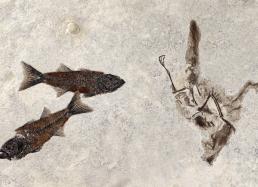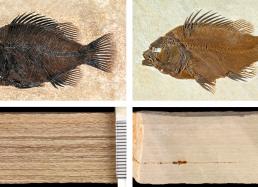The Green River Formation
Together, Fossil Lake, Lake Uinta, and Lake Gosiute formed the Green River Lake System that covered parts of modern-day Wyoming, Utah, and Colorado. These large lakes persisted for around 12 million years—longer than most known lake systems on Earth! In comparison, today’s Great Lakes are only about 10 thousand years old.
Throughout its incredible lifespan, the Green River Lake System laid down one of the largest accumulations of lake sediments in the world: the Green River Formation. Extending for more than 65,000 square kilometers (25,000 square miles) and reaching 600 meters (2,000 feet) or more in thickness, the Green River Formation includes 14 different "Members"—subdivisions that represent different places in time and location.
The Fossil Butte Member
As the smallest and shortest-lived of the three Green River Lakes, Fossil Lake persisted for two million years and is marked by three sedimentary Members. The Road Hollow Member is the oldest and thickest and represents the formation of Fossil Lake as it grew and deepened. The Angelo Member is the youngest and chronicles the demise of the lake, when it became too salty to sustain aquatic life.
Sandwiched in the middle is the Fossil Butte Member. It documents only a few tens of thousands of years—but what a record! Its sediments contain a greater number of aquatic species than all the other Green River Members combined. Even land-dwelling species are perfectly preserved, from tiny pollen spores and giant palm fronds to birds, bats, and microscopic bacteria.
The Mother-load Layers
Two of the most productive and easiest to excavate layers within the Fossil Butte Member include the “18-inch layer” and the “sandwich bed.” Minerals in the 18-inch layer record mid-lake life in somber shades, turning the bones of fishes black and their scales grey. In contrast, the “sandwich beds,” which measure up to 6.6 feet thick, contain near-shores species that are typically tinted shades of orange and brown.
Together, these layers produce fossils so beautifully preserved that they resemble wildlife portraits, valued both for their scientific merit by paleontologists and for their aesthetic appeal by art galleries, interior decorators, architects, and collectors.




